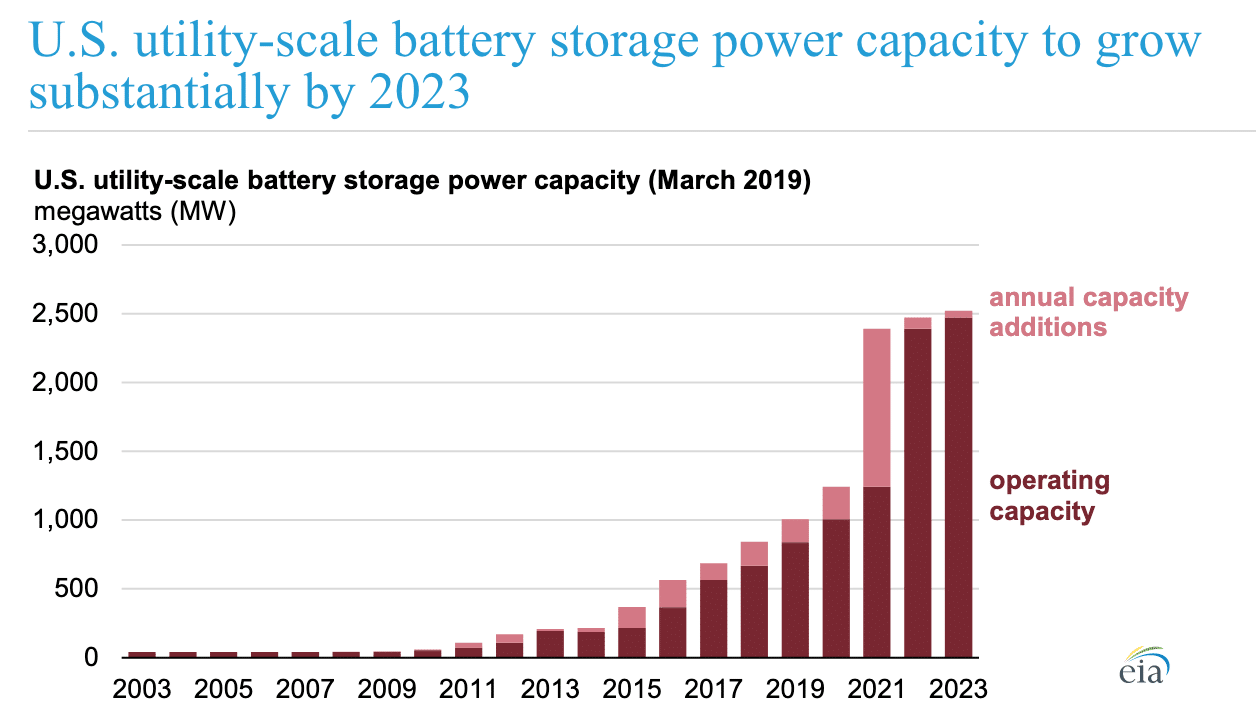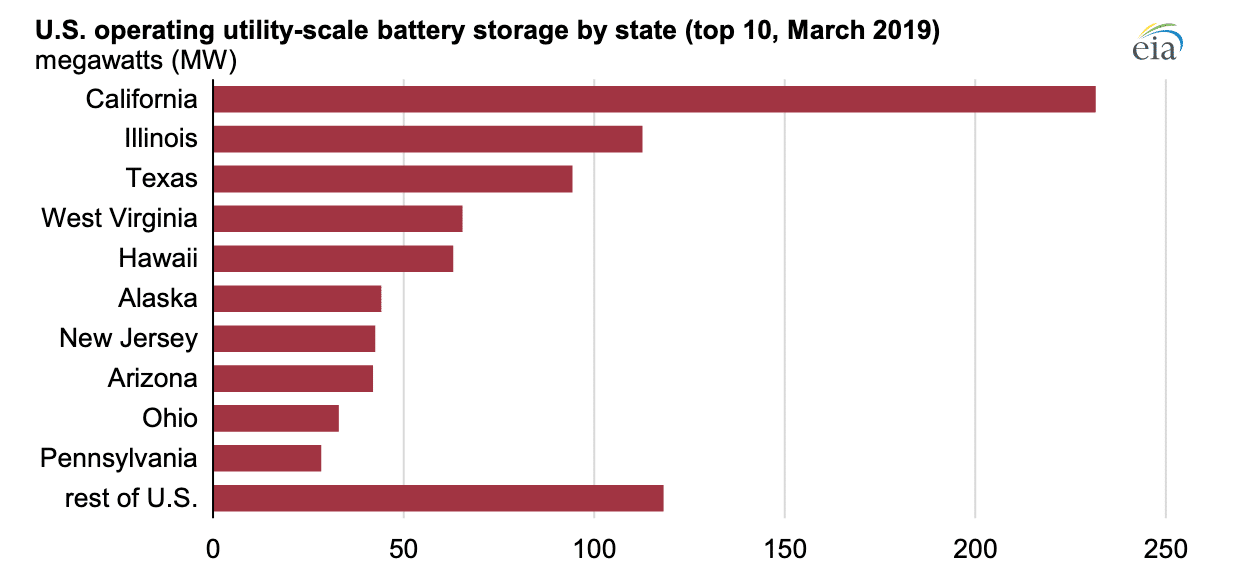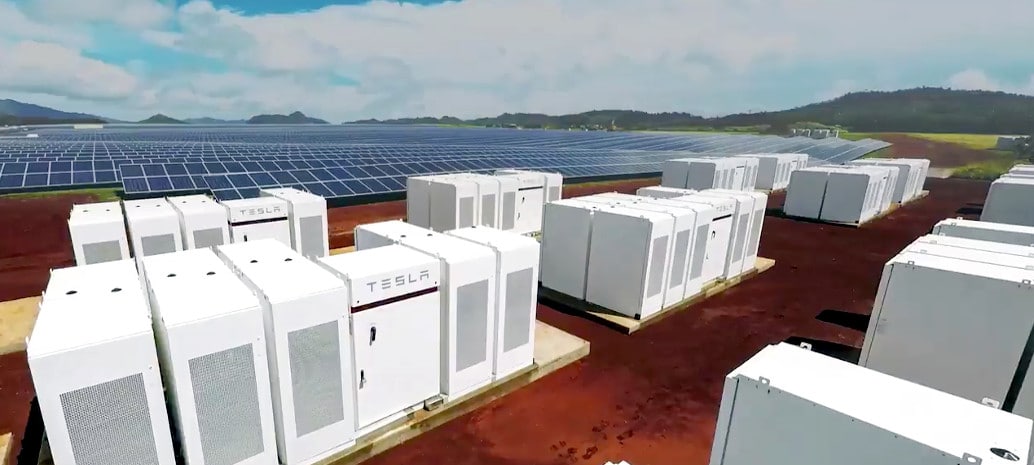Symbiosis is one of life’s most beautiful and lasting natural phenomena. Regardless of the circumstances, certain things just work perfectly together: peanut butter and jelly, sharks and pilot fish, Brady and Belichick. The energy revolution is no different, as renewable resources and battery storage go together like two peas in a pod.
However, to date the United States has only had 899 MW of operating batter storage. And while that figure is anticipated to reach 1 GW by year’s end, even then this is 1/67th of the total installed solar capacity and an even smaller percent of installed renewable energy capacity.
But that figure is about to change drastically, as the U.S. Department of Energy’s Energy Information Administration (EIA) has released a report predicting that the volume of battery storage will more than double to 2,500 MW by 2023.

Image: EIA
Future projections are based on proposed utility-scale battery storage projects scheduled for initial commercial operation within the next five years. EIA tracks this data with its Preliminary Monthly Electric Generator Inventory survey, which collects the updated status of any projects scheduled to come online within the next 12 months.
As drastic of a prediction as that 2.5 GW figure appears initially, it comes with precedent. From the end of 2014 to this past March, the volume of installed battery storage increased more than four times from 214 MW to 889.
When we look at the list of states that brought us to our current storage reality, the results may come as a surprise at first. Leading the way is California, and while this is unsurprising, of the six states known to pv magazine to have energy storage mandates, California is the only one present in the top-10. The others: Arizona, Nevada, New York, Massachusetts and Oregon each have less than 50 MW of batteries installed battery at the moment.

Image: EIA
Outside of California, Texas and Hawaii are also relatively unsurprising, as Texas has a huge installed capacity of wind, and Hawaii has been de facto requiring new rooftop PV systems to pair with battery storage. Right away, however, the names that stand out in this list are West Virginia, Pennsylvania and Ohio. None of those states are known for being renewable energy pioneers; they have just under 650 MW of installed solar between them. Special recognition goes out to West Virginia for its 8.5 MW.
So what’s with all the storage? Independent of renewables, West Virginia, Pennsylvania and Ohio, as well as New Jersey, the #7 state on the above list, are all members of PJM Interconnection. PJM was the first large market for battery storage, with policies that encouraged the use of batteries for frequency regulation.
However, this list will likely look very different already by the time 2023 rolls around. Of the 1,623 MW expected to come on-line by the end of 2023, 725 of those MW will come courtesy of two projects, projects contained in states not currently in the top-10.
The first of these is Florida Power and Light’s (FPL) battery system under construction in its Manatee Solar Energy Center in Parrish, Florida. The battery is set to clock in at an unbelievable 409 MW, which will make it the largest solar-powered battery system in the world.
In that project’s shadow, but capable of casting a massive shadow of its own comes the Helix Ravenswood facility, planned to be located in Queens, New York. Almost more impressive than the project’s anticipated 316 MW power rating is the idea of having a storage project of such magnitude located within New York City.
FPL’s Manatee Solar Energy Center battery is anticipated to begin commercial operation in 2021, as is the first stage of the Helix Ravenswood facility. This first stage will represent 129 MW, with the remaining 187 MW following via the 98 MW 2nd phase and 89 MW 3rd phase. The anticipated commercial operation dates of those phases have not yet been announced.
We have seen the future and there are batteries there, lots of them, a lasting representation that symbiosis extends far beyond the natural world.
This content is protected by copyright and may not be reused. If you want to cooperate with us and would like to reuse some of our content, please contact: editors@pv-magazine.com.









It is reassuring to see the EIA reporting on Batteries in a somewhat positive light. However, the analysis is clearly bogus after 2021 where they show only tiny Battery increases going forward. Think about it — the cost of Batteries is exponentially declining which alone will drive ever greater adoption … that’s basic economics. Add to it the “issues” raised by the Solar PV “Duck Curve”, perhaps the only significant argument against PV, which is Completely Solved by more Batteries. And with more and more PV going in, this only elevates the value of Batteries! With those two basically undisputed factors pushing Battery deployment, there is very little grounds for EIA’s truly anemic Battery Deployment projections after 2021.
We look forward to the day that intelligence regarding the “obvious” rules at the EIA. Thankfully, it does actually “rule” the market, albeit with far less gusto than if our supposed “leaders” woke-up and started putting ALL the pieces together before making projections. EIA has over the last decade ‘sort of’ learned their error on this in the PV market. Judging from that decade plus ‘sort of’ EIA wake-up, it will unfortunately be a while before they “get it” in the rest of the #RE100 realm.
This is like the EIA’s coal “projections” in reverse. For coal they predict a couple of years of high retirement and then the rest of the U.S. coal generation will stay working forever.
Here they see battery deployment doubling in 2021 and then nobody will ever buy and deploy a battery system ever again.
Indeed, with the move towards less ‘commodity’ fueled generation resources and the push for more distributed generation and energy storage, the utilities will continue to DO what they have always done to protect their “regulated monopoly” and ‘revenues’. As energy storage becomes more important, folks will (justify) the cost to install their own energy storage systems behind the meter in their homes.
IF the utilities won’t do it, the people will. The grid is bi-directional, the utility wants to keep it uni-directional in the name of their revenues. The utility laughs at a modest 10kWh of energy storage. Yet, each resident is a drop, the drops become a trickle, the trickles become a stream, the streams become rivers. Most of these ‘articles’ and ‘studies’ seems to focus on the utility generation and distribution of electricity for domestic use. When one gets to the concept of changing transportation to all electric, now there’s another problem all together. They ‘talk’ of GW of distributed storage, other articles have touched on something like 50 to 100GW of distributed energy storage. When it becomes all encompassing, we actually need a couple of TW of energy storage to address the demand of a daily source of ‘juice’ for our transportation needs.
Assume each electric car BEV or HPEV has 30 kw battery capacity and by 2025 the US has 10 million such vehicles plugging into grid V2G then we will have 300,000 MW of battery storage capacity available to society at no cost to the electric sector since its all borne by the auto sector! Now think out the ramifications thereof in all this bs on utilities putting up massive battery storage capacity at consumers’ cost ad infinitum
Only to be accelerated further as Vehicle-to-Grid (V2G) becomes more widespread.